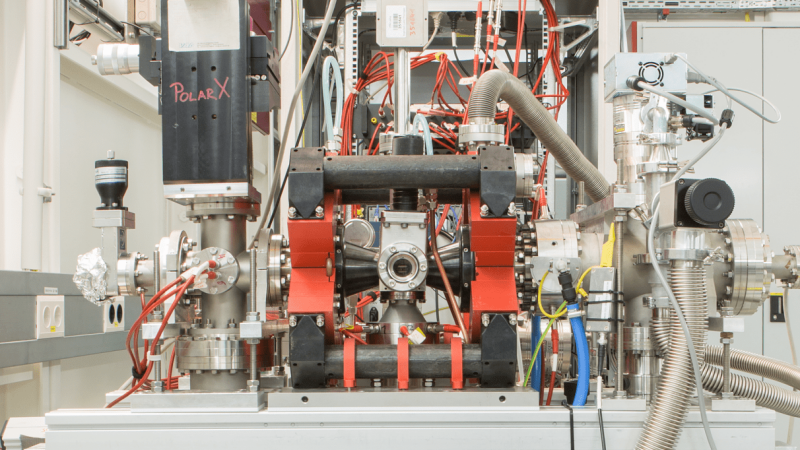Laboratory UV and X-ray astrophysics
The spectra of astrophysical objects in the UV and X-ray regions often exhibit a large number of emission and absorption lines originating from highly charged ions. The observed wavelengths and strengths of these lines could be used to obtain valuable information about the composition, temperature, density, and dynamics of the objects. A necessary prerequisite for this is a deep understanding of the underlying atomic physics processes. The compact electron beam ion trap PolarX-EBIT was developed to study the interaction of highly charged ions and photons at radiation sources such as the PETRA IIIExternal link synchrotron in Hamburg. These experiments, as well as planned complementary measurements at the CRYRING@ESRExternal link storage ring in Darmstadt, help to refine existing models of astrophysical plasmas.
PolarX-EBIT at PETRA III, trap center with stored highly charged ions in the center of the picture
Image: Marta Mayer (DESY)The PolarX-EBIT was designed, built and commissioned in close cooperation between staff from the University of Jena, the Max Planck Institute for Nuclear Physics (MPIK)External link in Heidelberg and the Physikalisch-Technische Bundesanstalt (PTB)External link in Braunschweig. This was funded by the German Federal Ministry of Education and Research (BMBF). It uses a beam of electrostatically accelerated electrons to ionize the gas atoms step-by-step by impact into high charge states. In the process, the beam is guided and compressed by a magnetic field generated by 72 neodymium permanent magnets. The negatively charged electron beam attracts the positively charged ions and traps them in the center of the trap. There they can interact with UV or X-ray radiation coming from outside, while detectors record the spectra of the resulting fluorescence. In close collaboration with a number of international collaborators, including NASA Goddard Space Flight Center (GSFC)External link, Lawrence Livermore National Laboratory (LLNL)External link and Dr.-Karl-Remeis-Sternwarte BambergExternal link, several experiments on astrophysical questions have already been carried out in this way.
An independent experiment on the interaction of highly charged ions with neutral gas is currently in preparation at the CRYRING@ESR storage ring. Of particular interest is the UV and X-ray radiation that occurs when ions capture electrons from neutral gas. This charge exchange process is of considerable interest for the interpretation of astrophysical X-ray spectra.
References:
[1] M. A. Leutenegger et al., Phys. Rev. Lett 125, 243001 (2020), https://doi.org/10.1103/PhysRevLett.125.243001External link
[2] S. Kühn et al., Phys. Rev. Lett 124, 225001 (2020), https://doi.org/10.1103/PhysRevLett.124.225001External link
[3] P. Micke et al., Rev. Sci. Instrum. 89, 063109 (2018), https://doi.org/10.1063/1.5026961External link
[4] C. Shah et al., ApJ 833, 52 (2016), https://doi.org/10.3847/1538-4357/833/1/52External link
